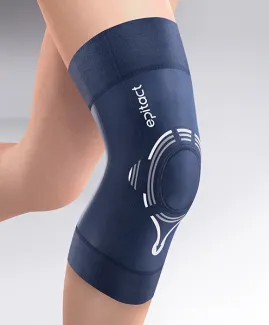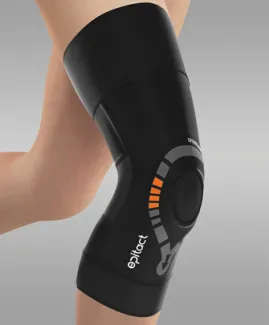Exercises for arthritic knees are part of the first recommendations to treat the pain(1). When they are associated with loss of weight and wear of a support brace, they can be very beneficial. However, can you do exercises with knee pain? What are the best and worst exercises for knee arthritis? EPITACT® gives you advice on the exercises to strengthen your knees.
Are knee arthritis and sports compatible?
Having physical activity with knee arthritis is recommended. At this moment, you may doubt and inversely think that the more you use your knees, the more they deteriorate. Well, this is a popular belief. Actually, even if the cartilage is already damaged, some specific exercises will help to preserve your joint. They include soft activities, which are less traumatic for your knees. No matter what, the benefits from sports and physical activities when having arthritic knees are superior to the risks of aggravating the condition(2).
Why should you do exercises for arthritic knees?
Arthritis is a degenerative condition: it can’t be cured, but it is possible to avoid or to slow down its progression. Sports, physical activities and strengthening exercises for knee pain are beneficial for several reasons(1, 2, 3, 4, 5, 7, 8) as they help to:
- ease the pain;
- prevent muscle weakness;
- relieve associated diseases like diabetes, cholesterol…
- fight excess weight, which is a major risk factor of knee arthritis;
- reduce the use of prostheses;
- improve the function of the knee and the leg, and so mobility;
- reduce the risks of falling;
- combat a sedentary lifestyle, social isolation and the feeling of inevitability associated with the disease;
- improve the quality of life.
Every patient must be aware of the many ways of relieving arthritic knees and limiting its progression using gentle methods. Among natural treatments, exercises for knee arthritis are a major issue in the management of the condition. In fact, it is very important to understand and make people understand that sport and exercise are therapeutic pillars. What's more, this method is quick and easy to apply, and inexpensive. Find out more about the various treatments for arthritic knees in a special article.
The best exercises for arthritic knees
If we decipher the scientific studies, we find 4 types of exercises for knee pain caused by arthritis(1, 3).
1. Activities of the daily life
Just being active is beneficial for knee arthritis. Indeed, the first thing to do if you have arthritic knees is to continue or resume activities of daily living. This may involve shopping, housework, gardening or any other activity that does not require intense joint effort(5).
2. Occupational activity
Maintaining your job or returning to it gradually also helps you to stay active. However, occupations that expose you to repeated trauma are not recommended; the work environment needs to be adapted to minimise these stresses(2). To help you, you can call on the services of an occupational therapist, who specialises in organising and adapting workstations.
3. Sports and physical activities
Not all sports are contraindicated for arthritis of the knee. Indeed, the most important thing for sportsmen and women is to be aware that joint trauma caused by certain activities can contribute to developing arthritic knees. The condition is to moderate the intensity and duration. If the activity you are practising causes pain, which is a sign of deterioration in the cartilage, the best option would be to change of exercises for your arthritic knees.
4. Physiotherapy exercises for knee pain
Finally, physiotherapy exercises for knees arthritis(3, 4, 6, 10, 11) are an essential part of treating the condition. They are performed under the supervision of a physiotherapist or at home, on the latter's recommendation. In addition to manual therapy sessions, home exercises are generally recommended.
Knee strengthening exercises
Exercises to strengthen the muscles around the joint helps to stabilise the knee. These exercises for arthritic knees focus on the quadriceps muscles or all the muscles of the leg. They help to reduce pain, improve functional abilities, and increase muscle strength.
Range of motion exercises
Flexibility and stretching exercises are often used to combat arthritis in the knees. These types of movements increase joint amplitude and improve mobility.
Proprioception movements
Motor control exercises involve working on joint stability during movement. Such exercises for arthritic knees target the muscles that stabilise the joint. When these muscles do not play their role sufficiently, the joint can become unstable or hypermobile.
How often and how intensively should you do exercises for knee pain?
The duration, intensity and frequency of exercises for knee arthritis are not fixed and will be estimated on a case-by-case basis. However, many studies agree on an average duration and frequency of 30 to 60 minutes of physical activity three times a week(4). In terms of intensity, start light then gradually increase the level of exercise if the pain allows.
When you draw up your exercise programme with your health professional, make sure that it is compatible with your physical abilities and your availability. It should also consider your age, the degree of disability and the intensity of the pain. Appropriate, moderate and gradual activity is essential to help you adhere to the treatment.
To facilitate this change in lifestyle, one study recommends making your exercise session part of your daily morning routine, before showering or breakfast(6).
What is the best sport for arthritis of the knee?
The best physical activity for arthritis of the knee is one that does not put excessive pressure on the joint. At present, there are no specific indications as to which activities are best for knee arthritis. However, cycling and walking could be less traumatic for the joint(2, 4). Exercises performed in water (e.g. swimming) may also have a beneficial effect on pain and function. Similarly, recommendations highlight the benefits of exercises for arthritic knees like tai chi and yoga(6, 9).
Conversely, team or contact sports that involve repeated impact on the joint should be avoided. A final word of advice to sportsmen and women: take good care of your injuries! A poorly treated injury can contribute to developing arthritic knees or a recurrence of a more serious injury.
Make it easier to resume or continue your activities with EPITACT®!
As a complement to exercises for your knee pain, knee support braces are often used.
To relieve pain during your daily activities, try the PHYSIOstrap® Médical* knee brace! This comfortable device can be worn discreetly under all types of clothing. Its technical design incorporates a patellar support tendon to help stabilise your knee effectively. It is very thin, and thanks to its silicone bands, it guarantees ideal support, so you'll forget you are wearing it all day long!
EPITACT® has also developed PHYSIOstrap® Sport* to help you continue or resume physical activity and sport. With its patented patellar tendon and high-performance compression fabrics, it guarantees reinforced support for the patella and good knee stability during sporting activities. It stays very well in place, even in the water. What's more, the fabric is ultra-thin on the kneecap and behind the knee, so there's no added pressure on the joint and no irritation.
You have arthritic knees and want to relieve your pain and reduce their progression? See your GP who can prescribe physiotherapy sessions. Your physical therapist will work with you to tailor exercises for your knee arthritis, in the clinic and/or at home. He or she will also be able to advise you on the best practices for your daily and physical activities. Find out more about how to stop the pain of knee osteoarthritis here.
*These solutions are class I medical devices that bear the CE marking under this regulation. Carefully read the instructions before use. Manufacturer: Millet Innovation. 03/2024
For more details about this general and simplified approach, here are further sources:
(1)Sanchez K, Eloumri A, Rannou F, Poiraudeau S. Prises en charge non pharmacologiques et non chirurgicales de l’arthrose : orthèses, exercices. La Presse Médicale. 1 nov 2010;39(11):1172 9.
(2)Poitras S, Rossignol M, Avouac J, Avouac B, Cedraschi C, Nordin M, et al. Recommandations pour le traitement de l’arthrose du genou : sont-elles applicables ? Revue du Rhumatisme. 1 janv 2011;78(1):69 77.
(3)Minerva. Quel type d’exercice physique pour l’arthrose du genou? Minerva. 2015;14(2):20 1.
(4)Vignon É, Valat JP, Rossignol M, Avouac B, Rozenberg S, Thoumie P, et al. Arthrose du genou et de la hanche et activité : revue systématique internationale et synthèse (OASIS). Revue du Rhumatisme. 1 juill 2006;73(7):736 52.
(5)Quelle activité physique dans l’arthrose ? Revue du Rhumatisme Monographies. 1 juin 2021;88(3):203 8.
(6)Fernandes L, Hagen KB, Bijlsma JWJ, Andreassen O, Christensen P, Conaghan PG, et al. EULAR recommendations for the non-pharmacological core management of hip and knee osteoarthritis. Ann Rheum Dis. juill 2013;72(7):1125 35.
(7)Henrotin Y, Chevalier X. Recommandations sur la prise en charge de l’arthrose de la hanche et du genou. Pour qui ? Pourquoi ? Pour quoi faire ? La Presse Médicale. 1 nov 2010;39(11):1180 8.
(8)Uthman OA, Windt DA van der, Jordan JL, Dziedzic KS, Healey EL, Peat GM, et al. Exercise for lower limb osteoarthritis: systematic review incorporating trial sequential analysis and network meta-analysis. BMJ. 20 sept 2013;347:f5555.
(9)Bannuru RR, Osani MC, Vaysbrot EE, Arden NK, Bennell K, Bierma-Zeinstra SMA, et al. OARSI guidelines for the non-surgical management of knee, hip, and polyarticular osteoarthritis. Osteoarthritis and Cartilage. juill 2019;S1063458419311161.
(10)Brosseau L, Taki J, Desjardins B, Thevenot O, Fransen M, Wells GA, et al. The Ottawa panel clinical practice guidelines for the management of knee osteoarthritis Part one: Introduction, and mind-body exercise programs. Clinical Rehabilitation. mai 2017;31(5):582 95.
(11)Brosseau L, Taki J, Desjardins B, Thevenot O, Fransen M, Wells GA, et al. The Ottawa panel clinical practice guidelines for the management of knee osteoarthritis. Part two: strengthening exercise programs. Clin Rehabil. mai 2017;31(5):596 611.
 Pharmacie
Pharmacie
